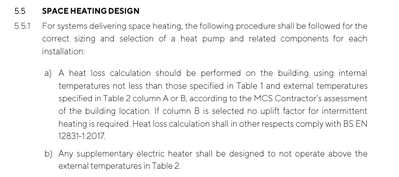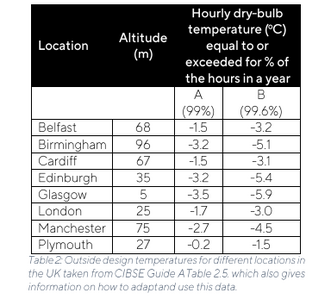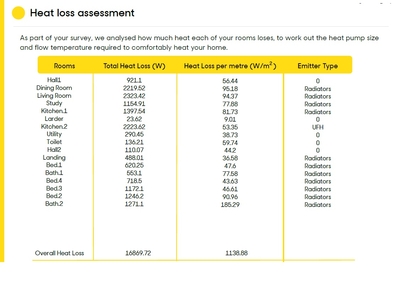Is a Valliant Inline 6kW heater a BUS buster?
Like many newbies desperately trying to ASHP an old house from oil fired, I have been down many rabbit holes - in brief, three phase not possible (£44K quote from National Grid), 18kW heat loss (Good Energy onsite survey), new ASHP-ready UFH in kitchen extension.
One recent suggestion was the (very expensive) Grant VortexAir 15/26kW Oil Boiler and 17kW Heat Pump Hybrid - definitely NOT BUS compliant, but at least a start.
However I might have cracked it - or have I?
I am considering a Vaillant aroTHERM plus 12kW combined with a Valliant Inline 6kW back-up heater. Looking initially for 45-55 degs flow temp to start (separating the UFH) while we change our rads over the next 12-18 months when finances allow. Plus keeping the existing Joule 300L tank (which we COULD use with just an immersion if ever required).
Is this BUS compliant?? We are replacing our old Grant Oil burner - we're rural and not on the gas network (yes we have wood burners but let's not go there!!).
Good Energy told me in their opinion this was NOT BUS compliant, my installer said it was but was told by the authorities that until he sends in the documentation they can't tell him (!), Chat GPT is convinced it is as well (!!), but surely I am replacing the fossil fuel with electricity throughout?
I'd welcome any thoughts....many thanks
this is the inline heater:
This has come up before; a close neighbour of mine did something similar and claimed the BUS grant, but of course that doesn't mean it is OK.
I would say this is debatable, which means that until the matter goes to court (which it probably never will) we don't know for certain. If I were a lawyer (which I am not) I would be more comfortable arguing that it is a BUS buster, but would be quite prepared to argue that it isn't, if that were the requirement.
The definitive BUS requirements are here
2(b) and 2(c) are the key provisions, but 1(d) and 1(e) are also relevant.
The question appears to amount to, where is the boundary of the 'heat pump' - in particular does the 'heat pump' include the backup heater. If it were internal to the box (some are, albeit not Vaillant's), most people would probably say it is. But what if its separate? 2c could help, but this refers to the original heating system. (as an aside I think one might argue that a strict interpretation of this may exclude a new immersion heater, which is almost always included in installations!). However is it logical to come to a different conclusion when a backup heater is in the same box to that when it isn't - obviously not!
There is also some scope for an argument about the phrase (in the BUS rules) 'it is capable of meeting the full space heating and hot water heating demands of that property'. What are the 'full' demands. MCS has an interpretation based on room temperatures and % of days that the capacity is sufficient, but is this the BUS interpretation. In any case 'the demands of the property' depends on its owners. One person may require the property to be heated to 25C for a very good reason, another to 18C. By default most will take it that the demands are defined by the MCS rules, but if you really wanted to have an argument...
In conclusion, a definite maybe IMHO.
In addition to the BUS requirements there are also MCS requirements (MIS3005-D), which may clinch the matter. These include this
Seemingly this says that supplementary heaters may be included, but only for operation below the design temperature. However this text is followed by some 'get outs' which could well allow a supplementary heater to be included within the MCS rules, so then the barrier reverts to the BUS rules.
Not entirely helpful I admit, other than to say I don't think there is an absolutely definitive answer. If pushed I would say that relying on an external backup heater at the design temperature is doubtful, however if you can find an installer to do it (which probably you can) the risk is very small. Maybe someone else can give a more definitive interpretation.
All that said I have to ask about 18kW? Are you sure? You must have a very large and very leaky house to require 18kW, or live somewhere very cold. Can I ask how this figure was arrived at. There is a bit of an epidemic of overestimating heat loss in the industry so its always worth being suspicious when very high losses are quoted. I had two 3hr surveys both of which claimed my house loss is 16kW, its actually 7kW. Its not at all impossible that the 12kW Vaillant without the backup heater is capable of meeting the entire demand! Just saying!
Perhaps post a bit more detail so we can look at options.
4kW peak of solar PV since 2011; EV and a 1930s house which has been partially renovated to improve its efficiency. 7kW Vaillant heat pump.
Wow @jamespa thanks so much for this - I am lucky enough (in our very hot summers!) to live in Somerset in an 1840s vicarage made of blue lias stone (external walls c. 450-500mm). It's approx 300m2, with a very large loft space and a cellar (both insulated). Most walls have no added insulation, some wooden floors downstairs are insulated, the rest are blue lias flags. Modern double glazing throughout.
The new 40m2 kitchen extension is to current building regs. It IS quite a cold house - partly due to the very open staircase (skylight above) so the heat escapes upstairs (we're adding a new rad in the hall to counteract/create an envelope I think it's called).
Attached is the heat loss estimate - my bad, it's only 16.9kW, so a small win!
It is going to be high loss. I have heard that the commonly assumed U values for stone walls is way to high, and the air changes is also often too high, so it still might be less than you think.
Do you have any way to get an independent handle on loss - eg if you heat it reasonably well most of the time your total annual oil consumption. If you can convince yourself its in the 12kW region then the backup heater becomes a true backup and the argument may go away
4kW peak of solar PV since 2011; EV and a 1930s house which has been partially renovated to improve its efficiency. 7kW Vaillant heat pump.
@guydeb I take it you've not explored the option of using a single phase to 3 phase converter to run a 18kW 3-phase heat pump. Instead of £44k on a grid supply you could purchase an inverter for considerably less.A quick search suggests such a converter would cost in the region of £2.5k.
Something to consider?
Posted by: @guydeb@jamespa thanks. For a fossil fuel comparison we spent approx £2,500 (av. 71p per litre) - £2,800 (av. 85p per litre) per year on oil (2023 and 2022 figures). We both work from home....
Ok so that's 35MWh and 32MWh respectively, assuming 10kWh/l, indicative of 11-17kW assuming the boiler is 100% efficient (which it likely isn't) and that the whole house is heated (or at least warm). So your 12kW Vaillant plus a backup is probably about right, the backup heater won't be used much I guess.
I think Vaillant have announced a 16kW model which would likely suffice on its own, not sure about availability. FYI Vaillants tend to deliver more than their sticker output not less. You might get away with a 14kW Ecodan (not sure if it's available single phase) but you would need somehow to refine the loss calculation. One thing I would consider is to get air changes measured and insert the correct figure instead of the the one assumed - this costs about £300, perhaps a bit more in your case because of the size of the house, and will have the side benefit of telling you where there are leaks that could be bunged up.
Cascades (more than one heat pump in series) are another possibility but complex and likely unnecessary. That said a 12 plus a 6 would give a brilliant range of modulation and could be super efficient with the right control. I would be wary about 1-3 phase inverters, the load on the incoming mains remains on the single phase and your electric company might get upset about phase imbalance.
I think there is enough there that there is a reasonable probability its soluble with a single unit, with a cascade as a backup solution in extremis. If you can't find an installer to do the 12kW Vaillant plus backup heater, then you need to refine some calculations to nail an alternative. That's probably a good idea anyway TBH, gross oversizing is nearly as bad as under sizing, so you want to get it as right as possible at this level of loss.
Is there any option to insulate?
Incidentally you need a good installer for this. Normally I would say avoid buffer tanks, LLHs and PHEs between heat pump and emitters at all cost (because it will increase your bills by 15%+ and make fault finding more difficult) but this might just be an exception. You really want someone who tries hard to avoid and, if they do conclude its absolutely necessary then have a really solid engineering justification and set it up properly. Not many are capable of doing that. If you have UFH in kitchen and rads elsewhere, rad sizing will be important too. Not much point having UFH designed to work at 35C and rads that need 55C because you will end up running at 55C and mixing down, sacrificing the efficiency benefit of the UFH. You may be looking at fancoils for some rooms; they are expensive (~£500 each) but that's peanuts compared with some of the figures you are quoting. I have been impressed with the one fancoil I have in my rather smaller (200sqm/7kW) house, I wish I'd fitted a few more so I could do decent cooling, and because they are nice and small.
This is an interesting project and I encourage you to keep asking questions.
If you haven't already I recommend you read this introduction
4kW peak of solar PV since 2011; EV and a 1930s house which has been partially renovated to improve its efficiency. 7kW Vaillant heat pump.
-
UFH and ASHPs
2 months ago
-
ASHP install contract and BUS grant money
4 months ago
Currently viewing this topic 1 user ( JamesPa ) and 2 guests.
- 26 Forums
- 2,111 Topics
- 46.4 K Posts
- 85 Online
- 3,402 Members
Latest Posts
-

RE: Is a Valliant Inline 6kW heater a BUS buster?
Ok so that's 35MWh and 32MWh respectively, assuming 10k...
By JamesPa , 27 minutes ago
-

@pie_eater I have been thinking of adding cooling to my...
By TechnoGeek , 2 days ago
-

RE: BUS Grant: removal of all other fossil fuel heat sources
Hi all, thanks for your help. The installer has confirm...
By Rikiarn , 2 days ago
-

RE: No-code, plug-and-play monitoring for your heat pump
Just in case anyone is looking at Planet Atmo- we've ma...
By benson , 3 days ago
-

RE: Victorian Semi Retrofit / Extension ASHP and UFH Advice
Agree, but you may have a hard time convincing them, as...
By JamesPa , 3 days ago
-

RE: Seal the Deal: Don't Let Your Heat Pump Leak Energy
Hi - fyi - there's a dead image link in the 'Optimal In...
By seatonian , 4 days ago
-

RE: Ripped Off: How UK Homeowners Are Paying Gas Prices for Wind Energy
@chandykris Horses and beggars…. 😉 Toodles.
By Toodles , 4 days ago
-

RE: Cleaning up after gas meter removed
@agentgeorge Likewise in the loft space; we have 300mm ...
By Toodles , 4 days ago
-

RE: Ecodan consuming 100kwh per day in new build!!!
This particular example is one of the worst I have seen...
By JamesPa , 4 days ago
-

-

RE: Fan running in hot weather ...why?
I wonder if it has some kind of pressure transducer to ...
By ASHP-BOBBA , 5 days ago
-

RE: Cooling with Samsung Gen6 and Flow error
@iaack The system isnt running long enough for any cond...
By EcoBaker , 5 days ago
-

@heacol thanks for confirming we can only hope NAPIT ag...
By Bart , 5 days ago
-

Sorry to hear that @bruce. Sadly I’ve heard from multip...
By Mars , 6 days ago
-

RE: Crystal Ball Time: Communal or even Area Energy Storage?
I am invested in a couple of listed energy storage fund...
By Old_Scientist , 7 days ago
-

RE: Who's your electricity provider and what's your tariff?
That would be my biggest commitment -time to gain great...
By SUNandAIR , 7 days ago
-

RE: Who has a V2G EV installation
As has been discussed on other threads, trying to justi...
By Majordennisbloodnok , 1 week ago








